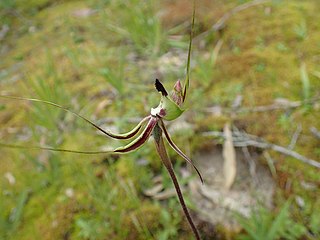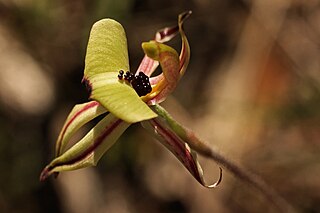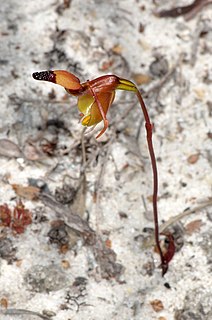
Caleana, commonly known as duck orchids, is a genus of flowering plants in the orchid family, Orchidaceae that is found in Australia and New Zealand. The Australian species are found in all states but have not been recorded in the Northern Territory. Duck orchids have a single leaf and one or a few, dull-coloured, inconspicuous flowers. Most species are found in Western Australia but one species occurs in eastern Australia and one occurs in eastern Australia and New Zealand. Orchids in this genus as well as the hammer orchids (Drakaea) are pollinated by male thynnid wasps.

Caladenia exstans, commonly known as the pointing spider orchid, is a species of orchid endemic to a small area in the south-west of Western Australia. It has a single, hairy leaf and one or two green, yellow and red flowers with a labellum which does not curl downwards but "points" forward.
Caladenia incrassata, commonly known as the puppet clown orchid is a species of orchid endemic to the south-west of Western Australia. It has a single, hairy leaf and usually only one greenish-yellow and red flower which has a red-striped labellum.

Caladenia roei is a species of orchid endemic to the south-west of Western Australia. It is also known as the common clown orchid, clown orchid, ant orchid, man orchid and jack-in-the-box. It has a single erect, hairy leaf and up to three greenish-yellow and red flowers with a relatively broad labellum. It is a common orchid throughout the south-west and is especially common on granite outcrops.

Caladenia aperta, commonly known as the western tiny blue china orchid, is a plant in the orchid family Orchidaceae and is endemic to Western Australia. It has a relatively narrow leaf and a single bluish-mauve flower. It is distinguished from the other two similar blue orchids by the sides of the labellum which are erect but well-separated from the column. This species also has a more easterly distribution than C. amplexans and C. sericea.

Caleana nigrita, commonly known as the small duck orchid or flying duck orchid is a species of orchid endemic to the south-west of Western Australia. It is the most common of the flying duck orchids and has the widest distribution of the Western Australian species. It has a single smooth leaf and is distinguished from the others by its labellum which has a hump in the middle and calli covering two thirds of its outer end. Its dull colouration makes it difficult to find, especially in areas that are blackened by fire.
Microtis eremaea, commonly known as the slender mignonette orchid or inland onion orchid is a species of orchid endemic to the south-west of Western Australia and western South Australia. It has a single thin, hollow, onion-like leaf and up to fifty small greenish-yellow flowers. The flowers have a distinctive heart-shaped labellum and the orchid generally grows in more inland areas than most other onion orchids.
Microtis eremicola, commonly known as the desert mignonette orchid or dryland onion orchid, is a species of orchid endemic to the south-west of Western Australia. It has a single hollow, onion-like leaf and up to fifty small, dull green to greenish-yellow flowers. This onion orchid is common in soil pockets on granite outcrops in inland areas, mostly between Hyden and Balladonia.
Microtis graniticola, commonly known as the granite mignonette orchid or granite onion orchid is a species of orchid endemic to the south-west of Western Australia. It has a single thin, hollow, onion-like leaf and up to sixty small green to greenish-yellow flowers. It grows in soil pockets on granite outcrops, especially where the soil receives run-off during rainy weather.
Caleana alcockii, commonly known as Alcock's duck orchid is a rare species of orchid endemic to the south-west of Western Australia. It has a single smooth leaf and is distinguished by its humped labellum and relatively late flowering period. It only occurs north of Geraldton.

Caleana brockmanii, commonly known as Brockman's duck orchid is a species of orchid endemic to the south-west of Western Australia. It has a single smooth leaf, a single greenish yellow and red flower and is distinguished by its flat labellum, relatively late flowering period and calli only near the tip of the labellum. It is found south from Perth.

Caleana triens, commonly known as broad-billed duck orchid is a species of orchid endemic to the south-west of Western Australia. It has a single smooth leaf and is distinguished by its flattened labellum with calli only near its tip and by its relatively early flowering period.
Caleana disjuncta, commonly known as the little duck orchid, is a species of orchid that is found in Western Australia but with a few disjunct populations in Victoria and South Australia. It has a single smooth leaf and a single greenish yellow and red flower with a flattened labellum, the calli only near its tip.
Caleana dixonii, commonly known as the sandplain duck orchid is a rare species of orchid endemic to the south-west of Western Australia. It has a single smooth leaf and a single greenish yellow and fawn-coloured flower. It is distinguished by its flattened labellum with calli only near the tip of the labellum and its preference for growing on sandplains.

Caleana gracilicordata, commonly known as the slender-leafed duck orchid is a species of orchid endemic to the south-west of Western Australia. It is a small, late flowering duck orchid with a single small, smooth, heart-shaped leaf and a single greenish yellow and red flower. It usually grows in mossy places on granite outcrops.

Caleana hortiorum, commonly known as Hort's duck orchid is a species of orchid endemic to the south-west of Western Australia. It has a single smooth leaf, a single greenish yellow and red flower and is distinguished by its long, narrow, slightly humped labellum, with calli on its outer half. It is found between Perth and Albany.
Caleana lyonsii, commonly known as the midget duck orchid is a species of orchid endemic to the south-west of Western Australia. It has a single smooth narrow leaf, up to ten greenish yellow flowers. It is distinguished by its narrow leaf which is usually withered by flowering time and its up to ten small, greenish flowers. It grows in harsh environments in disjunct populations between Kalbarri and Southern Cross and has the smallest flowers of its genus in Western Australia.
Caleana parvula, commonly known as the Esperance duck orchid is a species of orchid endemic to a small area near Esperance in the south-west of Western Australia. It has a single smooth leaf and usually only a single greenish yellow and red flower. It is distinguished by its small flower with the calli only on the outer one-fifth of the labellum. The only other Caleana species in Western Australia which is smaller is C. lyonsii.
Caleana terminalis, commonly known as smooth-billed duck orchid is a species of orchid endemic to a small area near the Murchison River in the south-west of Western Australia. It has a single smooth leaf and usually only a single greenish yellow and red flower. It is distinguished by its slightly humped labellum, with calli only on its outer one fifth.
Eriochilus dilatatus subsp. dilatatus, commonly known as the white bunny orchid, is a plant in the orchid family Orchidaceae and is endemic to Western Australia. It has a single narrow leaf and up to seven greenish and white flowers with reddish or mauve markings. A widespread and common species, it grows in a range of habitats and flowers prolifically after fire.


















